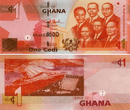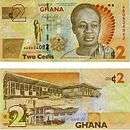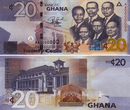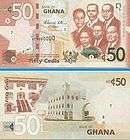Ghanaian cedi
| Ghanaian cedi | |
|---|---|
|
Cedi banknotes | |
| ISO 4217 code | GHS |
| Central bank | Bank of Ghana |
| Website |
www |
| User(s) |
|
| Inflation | 17% |
| Source | Ghana Statistical Service |
| Subunit | |
| 1/100 | Ghana pesewa |
| Symbol | GH₵ (Also often GH¢) |
| Ghana pesewa | Gp |
| Coins | 1, 5, 10, 20, 50Gp, GH₵1 |
| Banknotes | GH₵1, 2, 5, 10, 20, 50 |
The Ghana cedi (currency sign: GH₵; currency code: GHS) is the unit of currency of Ghana. It is the fourth and only legal tender in the Republic of Ghana. One Ghana cedi is divided into one hundred pesewas (Gp).
After it gained independence Ghana separated itself from the British West African pound, which was the currency of the British colonies in the region. The new republic's first independent currency was the Ghanaian pound (1958-1965). In 1965, Ghana decided to leave the British colonial monetary system and adopt the widely accepted decimal system. The African name Cedi (1965-1967) was introduced in place of the old British pound system. Its first president Kwame Nkrumah introduced Cedi notes and Pesewa coins in July 1965 to replace the Ghana pounds, shillings and pence. The cedi was equivalent to eight shillings and four pence (8s 4d) and bore the portrait of the President
After a military coup the new leaders wanted to remove the face of Nkrumah from the banknotes. The new cedi (1967-2007) was worth 1.2 cedi which made it equal to half of a pound sterling at its introduction. After decades of high inflation had devalued the new cedi, it was gradually phased out in 2007 in favor of the Ghana cedi at an exchange rate of 1:10,000. In 2007 the largest of the new cedi banknotes, the 20,000 note, had a value of about US$2. By removing four digits the Ghana cedi became the highest-denominated currency unit issued in Africa. It has since lost about 75% of its value.
Etymology

The word cedi is the Fante word for cowry shell which were formerly used as currency in what is now Ghana. The Monetaria moneta or money cowry is not native to West African waters but is a common species in the Indian Ocean. The porcelain-like shells came to West Africa, beginning in the 14th century, through trade with Arab merchants. The shells became an important currency in the slave trade. The first modern coins exclusively used at the Gold Coast was produced in 1796 but cowries was used alongside coins and gold dust as currency until 1901.[1]
History
First cedi, 1965–1967
| Preceded by: Ghanaian pound Reason: decimalisation Ratio: 2.4 first cedi = 1pound, or 1 pesewa = 1 penny |
Currency of Ghana 19 July 1965 – 22 February 1967 |
Succeeded by: Second cedi Reason: convenience of exchange and an opportunity to remove Kwame Nkrumah from coins and notes Ratio: 1 second cedi = 1.2 first cedis |
The first cedi was introduced in 1965, replacing the pound at a rate of 2.4 cedi = 1 pound, or 1 pesewa = 1 penny. The first cedi was pegged to the British pound at a rate of 2.4 cedis = 1 pound.
Second cedi (GHC), 1967–2007
| Preceded by: First cedi Reason: convenience of exchange and an opportunity to remove Kwame Nkrumah from coins and notes Ratio: 1 second cedi = 1.2 first cedis = 0.5 pound |
Currency of Ghana 23 February 1967 – 2 July 2007 |
Succeeded by: Third cedi Reason: inflation Ratio: 1 third cedi = 10,000 second cedis |
The first cedi was replaced in 1967 by a "new cedi" which was worth 1.2 first cedis. This allowed a decimal conversion with the pound, namely 2 second cedis = 1 pound. The change also provided an opportunity to remove Kwame Nkrumah's image from coins and notes.
The second cedi was initially pegged to the British pound at a rate of 2 cedi = 1 pound. However, within months, the second cedi was devalued to a rate of 2.45 second cedi = 1 pound, less than the value of the first cedi. This rate was equivalent to 1 cedi = 0.98 U.S. dollars and the rate to the dollar was maintained when the British pound was devalued in November 1967. Further pegs were set of $0.55 in 1971, $0.78 in 1972, and $0.8696 in 1973 before the currency was floated in 1978. High inflation ensued, and so the cedi was re-pegged at ₵2.80 = $1.00.
Inflation continued to eat away at the cedi's value on the black market. In the early eighties, the government started cracking down hard on the retail of products at prices other than the official established sale price (price controls). This had the effect of driving nearly all commerce underground, where black market prices for commodities were the norm, and nothing existed on store shelves. By 1983 the cedi was worth about 120 to one U.S. dollar on the black market, a pack of cigarettes cost about ₵150 (if they could be found), but the bank rate continued at ₵2.80 = $1.00. Finally, with foreign currency completely drying up for all import transactions, the government was forced to begin a process of gradual devaluation, and a liberalization of its strict price controls. This process ended in 1990 with a free float of the cedi against foreign currencies. Inflation continued (see exchange rate chart) until by July 2007, the cedi was worth about 9500 to one US dollar, and a transition to the third cedi was initiated.
In 1979 a currency confiscation took place. New banknotes were issued which were exchanged for old at a rate of 10 old for 7 new. Coins and bank accounts were unaffected.
A second confiscation took place in 1982, when the ₵50 note (the highest denomination) was demonetized. Ghanaians, in theory, could exchange any number of ₵50 notes for coins or other banknotes without loss, but foreigners could not make any exchange. However, many Ghanaians who were hoarding large amounts of cedis feared reprisal if they tried to convert all of it, and so simply burned a lot of their money. Many other Ghanaians received "promise payment notes" from the banks, but never received compensation. This confiscation was publicly justified as a means to create a disincentive for the flourishing black market. However, from a monetary perspective, currency confiscations have the effect of reducing the available cash in the economy, and thereby slowing the rate of inflation. After the ₵50 note confiscation, the ₵20 note was the highest cedi denomination, but had a street value of only about $0.35 (U.S.)
After the ₵50 note confiscation, fears existed that the government could also confiscate the ₵20 or even the ₵10 notes. This fear, along with inflation running at about 100% annually, started causing Ghanaian society to lose its faith in its own currency. Some transactions could only then be done in foreign currencies (although that was technically illegal), and other more routine transactions began to revert to a barter economy.
In 1991, 10, 20, 50, and 100 cedi coins were introduced, followed by 200 and 500 cedis in 1996. These six denominations were still in circulation till 2007. However, the 10 cedis (~0.1 U.S. cents) and 20 cedis (~0.2 U.S. cents) coins were not seen much due to their small value.[2]
Third cedi (GHS), 2007–
| Preceded by: Second cedi Reason: inflation Ratio: 1 third cedi = 10,000 second cedis |
Currency of Ghana 2 July 2007 – Present |
Succeeded by: Current |
Because of the rampant inflation in the decades before the exchange the second cedi was only worth a small fraction of its original value. The government decided to "cut" four zeros off the currency by the switch to the third cedi. The new currency was not introduced as the third cedi but is instead officially called the Ghanaian Cedi, in contrast to the second cedi that was officially known as the New Cedi. In the second half of 2007 both the second and third cedi were legal tender as the old currency were being gradually withdrawn. At the end of December 2007 more than 90% of all old coins and notes had been withdrawn.[3] From January 2008 old banknotes could only be exchanged at banks and was no longer legal tender.[4]
On 14 May 2010 a GH₵2 banknote was issued to meet public need for an intermediate denomination and reduce the frequency, and associated cost, of printing large volumes of the GH₵1 banknote. The introduction of the new denomination coincides with the conclusion of the year-long centenary celebrations of the birth of Kwame Nkrumah, Ghana’s first president, and has the commemorative text "Centenary of the Birth of Dr. Kwame Nkrumah".[5]
The third Cedi has been losing value continuously since it was introduced but in 2014 the inflation rose rapidly as the value of the third cedi fell to a fourth of its original value.[6] The fall was ended in the last quarter of 2014 as the currency stabilized due to a pending IMF bailout of Ghana.[7]
Coins
The Bank of Ghana have been issuing all Ghanaian coins since 1958.[8] Beside the coins in general circulation the bank have also issued commemorative coins[9] These special coins have been issued in shillings (1958), crowns (1965), pounds (1958-1977), sikas (1997-2003) and cedis (2013-).[10] It is unclear if the Bank of Ghana considered commemorative crowns and sikas together with the commemorative pounds that were coined after 1965 as legal tender or simply as medallions.[11]
Only coins that have been or are in general circulation are included in this list. The years of issue does not indicated that the series have been coined every year in the period but that the coin has been issued more than once in the stated period. Some coins are held back and released years after they are issued. This means that in the general circulation there are worn out coins and coins in mint condition from the same issuing year. The Bank of Ghana has never stated if they are simply holding back already stamped coins until they are needed or if they are stamping coins successively with old issue years.
Cedi (1965-67)
| Cedi (Legal tender: 1965-67) | |||||||||
|---|---|---|---|---|---|---|---|---|---|
| Image | Value | Description | Date of issue | ||||||
| Obverse & Reverse | Obverse | Reverse | Metal | Weight | Diameter | Edge | |||
.jpg) |
5 pesewas | Kwame Nkrumah (Lettering:) CIVITATIS GHANIENSIS CONDITOR (the Founder of Ghana) KWAME NKRUMAH |
Five-pointed star (Lettering:) The value of the coin & 1965 |
Copper/Nickel | 4.1 g | 22 mm | Smooth | 19 July 1965 | |
.jpg) |
10 pesewas | 3.2 g | 20 mm | Milled | |||||
.jpg) |
25 pesewas | 8.65 g | 27.4 mm | ||||||
.jpg) |
50 pesewas | 13.9 g | 32 mm | Reeded | |||||
New cedi
| New Cedi - 1st series (Legal tender: 1967-2007) | |||||||||
|---|---|---|---|---|---|---|---|---|---|
| Image | Value | Description | Years of issue | ||||||
| Obverse & Reverse | Obverse | Reverse | Metal | Weight | Diameter | Edge | |||
.jpg) |
½ pesewa | Adowa drums (Lettering:) GHANA FREEDOM AND JUSTICE |
Five-pointed star (Lettering:) The value of the coin & The year of issue |
Bronze | 2.9 g | 20.2 mm | Smooth | 1967 | |
.jpg) |
1 pesewa | 5.72 g | 25.47 mm | 1967-1979 | |||||
.jpg) |
2½ pesewas | Cacao fruits (Lettering:) GHANA FREEDOM AND JUSTICE |
The shield from the Coat of arms of Ghana (Lettering:) The value of the coin & The year of issue |
Copper/Nickel | 3.2 g | 19.5 mm | 1967 | ||
.jpg) |
5 pesewas | 2.85 g | 19 mm | Reeded | 1967-1975 | ||||
.jpg) |
10 pesewas | 5.6 g | 23.5 mm | 1967-1979 | |||||
.jpg) |
20 pesewas | 11.2 g | 28 mm | ||||||
.jpg) |
50 pesewas | 12.5 g | 32 mm | Milled | 1979 | ||||
.jpg) |
1 cedi | Cowry shell (Lettering:) GHANA FREEDOM AND JUSTICE |
Brass | 11.9 g | 30 mm | Smooth | |||
Ghana cedi
The new coins are 1 pesewa (100 old cedi), 5 pesewas (500), 10 pesewas (1,000), 20 pesewas (2,000), 50 pesewas (5,000), and 1 cedi (10,000). By 2011 the 1 pesewa had fallen out of circulation due to inflation and is mostly kept in bank vaults.[12]
Banknotes
The Bank of Ghana have been issuing all Ghanaian banknotes since 1958.[13][14] Most of the Ghanaian banknotes have been changed slightly from one years issue to the next years issue in the ongoing technological fight against counterfeit money. The signature of the notes does also change when a new governor takes over the management of the Bank of Ghana.[15] Such changes are plentiful and are not covered in this list. The years of issue does not indicated that the series have been printed every year in the period but that the banknote has been issued more than once in the stated period.
Cedi (1965-67)
| Cedi (Legal tender: 1965-67) | ||||||
|---|---|---|---|---|---|---|
| Image | Value | Description | Date of issue | |||
| Obverse & Reverse | Obverse | Reverse | ||||
.jpg) |
1 cedi | Kwame Nkrumah | Bank of Ghana | 19 July 1965 | ||
.jpg) |
5 cedis | Supreme Court | ||||
.jpg) |
10 cedis | Independence Arch | ||||
.jpg) |
50 cedis | Seashore, Palms | ||||
.jpg) |
100 cedis | Kumasi Central Hospital | ||||
.jpg) |
1,000 cedis (Only used in Interbanking Transactions) |
Black Star | Bank of Ghana | |||
New cedi (1967-2007)
1967 to 1979
| New cedi - 1st series (Legal tender: 1967-79) | ||||||
|---|---|---|---|---|---|---|
| Image | Value | Description | Years of issue | |||
| Obverse & Reverse | Obverse | Reverse | ||||
.jpg) |
1 cedi | Cocoa | Shield and sword | 1967-1971 | ||
.jpg) |
5 cedis | Fauna carvings | Fauna carvings | 1967-1969 | ||
.jpg) |
10 cedis | Art projects | Statuettes | 1967-1970 | ||
| New cedi - 2nd series (Legal tender: 1972-79) | ||||||
|---|---|---|---|---|---|---|
| Image | Value | Description | Years of issue | |||
| Obverse & Reverse | Obverse | Reverse | ||||
.jpg) |
1 cedi | School girl with headphones | Cocoa farmer | 1973-1978 | ||
.jpg) |
2 cedis | Farmer | Fishermen | 1972-78 | ||
.jpg) |
5 cedis | Market woman | Larabanga mosque | 1973-1978 | ||
.jpg) |
10 cedis | Pipe smoker | Akosombo Dam | |||
1979 to 2007
| New cedi - 3rd series (Legal tender: 1979-2007) | ||||||
|---|---|---|---|---|---|---|
| Image | Value | Description | Years of issue | |||
| Obverse & Reverse | Obverse | Reverse | ||||
.jpg) |
1 cedi | Young man | Basket weaver | 1979-1982 | ||
.jpg) |
2 cedis | School girl | Field workers | |||
.jpg) |
5 cedis | Northerner | Lumberers | |||
.jpg) |
10 cedis | Young woman | Fishermen | |||
.jpg) |
20 cedis | Miner | Kente weaver | |||
.jpg) |
50 cedis (Demonetized in 1982) |
Elderly man | Cocoa farmers | 1979-1980 | ||
| New cedi - 4th series (Legal tender: 1983-2007) | ||||||
|---|---|---|---|---|---|---|
| Image | Value | Description | Years of issue | |||
| Obverse & Reverse | Obverse | Reverse | Start | End | ||
.jpg) |
10 cedis | W. O. II Larbi, Fred Otoo, E. Kwasi Nukpor | Rural bank building | 1984 | 1984 | |
.jpg) |
20 cedis | Queen Mother Yaa Asantewaa | Miner, army officer, student, demonstrators | 1986 | ||
.jpg) |
50 cedis | Young man | Workers drying grain | 1983 | ||
.png) |
100 cedis | Woman | Loading produce | 1991 | ||
.jpg) |
200 cedis | Old man | Teacher and students | 1993 | ||
.png) |
500 cedis | Black star, fist, and "Gye Nyame" | Cocoa and miner | 1986 | 1994 | |
.png) |
1,000 cedis | Diamonds | Cocoa harvest | 1991 | 2003 | |
.png) |
2,000 cedis | Adomi Bridge | Fishermen | 1994 | 2006 | |
.png) |
5,000 cedis | Coat of arms of Ghana | Cargo ships and logs | |||
.jpg) |
10,000 cedis | The Big Six | Independence Arch | 2002 | ||
.jpg) |
20,000 cedis | Ephraim Amu | National Theatre of Ghana | |||
Ghana cedi (2007-Present)
| Ghanaian cedi | ||||||
|---|---|---|---|---|---|---|
| Image | Value | Dimensions | Main Colour | Description | First issued | |
| Obverse & Reverse | Obverse | Reverse | ||||
 |
1 cedi | 137 × 65 mm | Red | The Big Six, Independence Arch | Akosombo Dam | 3 July 2007 |
 |
2 cedis | 140 × 67 mm | Beige | Kwame Nkrumah | Parliament House | 14 May 2010 |
 |
5 cedis | 141 × 68 mm | Blue | The Big Six, Independence Arch | University of Ghana, The Balme Library | 3 July 2007 |
 |
10 cedis | 145 × 71 mm | Yellow-green | Bank of Ghana | ||
 |
20 cedis | 149 × 74 mm | Purple | Supreme Court | ||
 |
50 cedis | 153 × 77 mm | Brown | Christiansborg Castle | ||
Exchange rate history
| Date | Cedi per U.S. $ | Date | Cedi per U.S. $ |
|---|---|---|---|
| Cedi (First cedi) | |||
| 1965 | 0.824 | 1967 | 0.714 |
| New cedi (Second cedi) | |||
| 1970s | ~1.000 (0.833 to 1.111) | 1980 | 2.80 Bank rate (~20 Blackmarket) |
| 1983 | 30.00 Bank rate (~120 Blackmarket) (Oct 83) | 1984 | 35.00 (Mar 84); 38.50 (Aug 84); 50 (Dec 84) |
| 1985 | 50 – 60 | 1986 | 90 |
| 1987 | 150 – 175 | 1988 | 175 – 230 |
| 1989 | 230 – 300 | 1990 | 300 – 345 |
| 1991 | 345 – 390 | 1992 | 390 – 520 |
| 1993 | 555 – 825 | 1994 | 825 – 1050 |
| 1995 | 1050 – 1450 | 1996 | 1450 – 1750 |
| 1997 | 1750 – 2250 | 1998 | 2250 – 2350 |
| 1999 | 2350 – 3550 | 2000 | 3550 – 6750 |
| 2001 | 6750 – 7300 | 2002 | 7300 – 8450 |
| 2003 | 8450 – 8850 | 2004 | 8850 – 8900 |
| 2005 | 8900 – 9500 | 2006 | 9500 – 9600 |
| 2007 | 9600 – 9300 | ||
| Year | January 1 | May 1 | September 1 |
|---|---|---|---|
| 2008 | 0.930 | 1.005 | 1.155 |
| 2009 | 1.265 | 1.460 | 1.465 |
| 2010 | 1.430 | 1.425 | 1.440 |
| 2011 | 1.486 | 1.496 | 1.535 |
| 2012 | 1.639 | 1.855 | 1.932 |
| 2013 | 1.905 | 1.974 | 2.150 |
| 2014 | 2.353 | 2.823 | 3.723 |
| 2015 | 0.2594 | ||

| Current GHS exchange rates | |
|---|---|
| From Google Finance: | AUD CAD CHF EUR GBP HKD JPY USD |
| From Yahoo! Finance: | AUD CAD CHF EUR GBP HKD JPY USD |
| From XE: | AUD CAD CHF EUR GBP HKD JPY USD |
| From OANDA: | AUD CAD CHF EUR GBP HKD JPY USD |
| From fxtop.com: | AUD CAD CHF EUR GBP HKD JPY USD |
| From Currency.Wiki: | AUD CAD CHF EUR GBP HKD JPY USD |
See also
- Economy of Ghana
- Previous Ghana currencies:
References
- ↑ "Cowrie shells and the slave trade". British Museum. Retrieved December 20, 2014.
- ↑ "Metal cedis and pesewas - modern coins of Ghana". Allmoney.com. Retrieved December 20, 2014.
- ↑ "Don’t Give Out Change In Old notes, Coins". Modern Ghana. December 19, 2007. Retrieved December 20, 2014.
- ↑ "Time Out For Old Cedi Notes". Modern Ghana. December 31, 2007. Retrieved December 20, 2014.
- ↑ "Ghana new 2-cedi note confirmedn". Banknote News. July 23, 2010. Retrieved December 20, 2014.
- ↑ "Ghana Cedi at risk of sliding to 4 per Dollar, HFC says". Starrf. July 5, 2014. Retrieved December 20, 2014.
- ↑ "IMF bail out is to stabilize the cedi". B&FT. August 3, 2014. Retrieved December 20, 2014.
- ↑ "Bank of Ghana - A brief historical background". Bank of Ghana. Retrieved December 21, 2014.
- ↑ "Ghana coins". Numista. Retrieved December 23, 2014.
- ↑ George S. Cuhaj; Thomas Michael (15 September 2011). Unusual World Coins. Krause Publications. pp. 262–264. ISBN 1-4402-1712-2.
- ↑ "Ghanaian gold coins". Tax Free Gold. Retrieved December 23, 2014.
- ↑ "Ghana's 1 Pesewa Seldom Seen". NumisMaster.com. March 22, 2011. Retrieved December 20, 2014.
- ↑ "Banknotes of Ghana". Bank of Ghana. Retrieved December 21, 2014.
- ↑ "Bank Og Ghana issued banknotes". The Banknote Museum. Retrieved December 21, 2014.
- ↑ "Banknot News page about Ghana". Banknote News. Retrieved December 21, 2014.
- ↑ "United States dollar (USD) and Ghana cedi (GHS) Exchange Rate History". freecurrencyrates.com. Retrieved September 11, 2013.
External links
-
 News related to New Ghanaian currency introduced at Wikinews
News related to New Ghanaian currency introduced at Wikinews
| ||||||||||||||||||||||||||||||||||||||||
| ||||||||||||||||||||||
| ||||||||||
